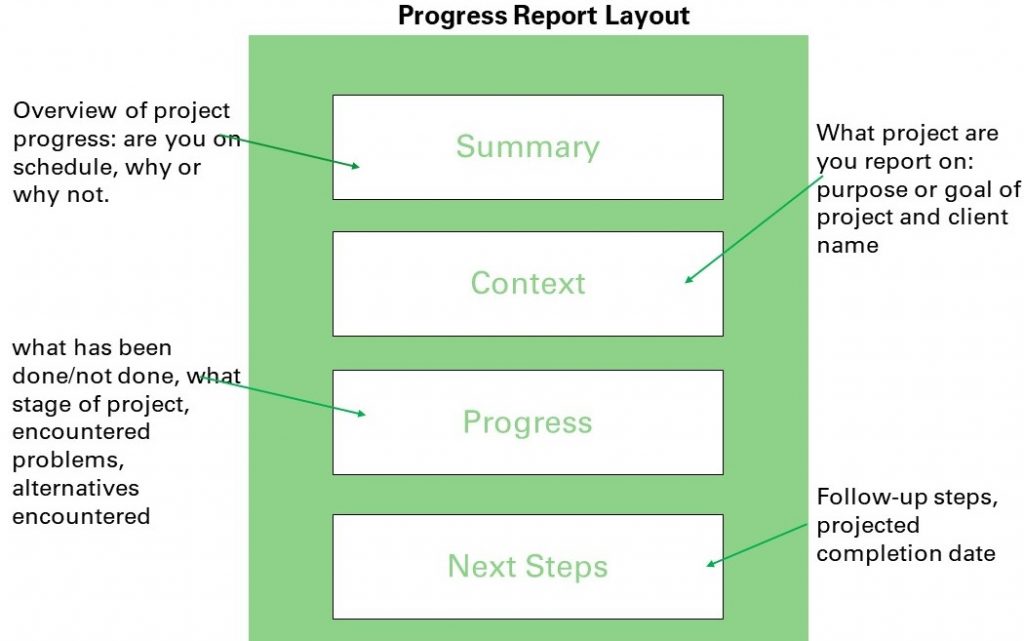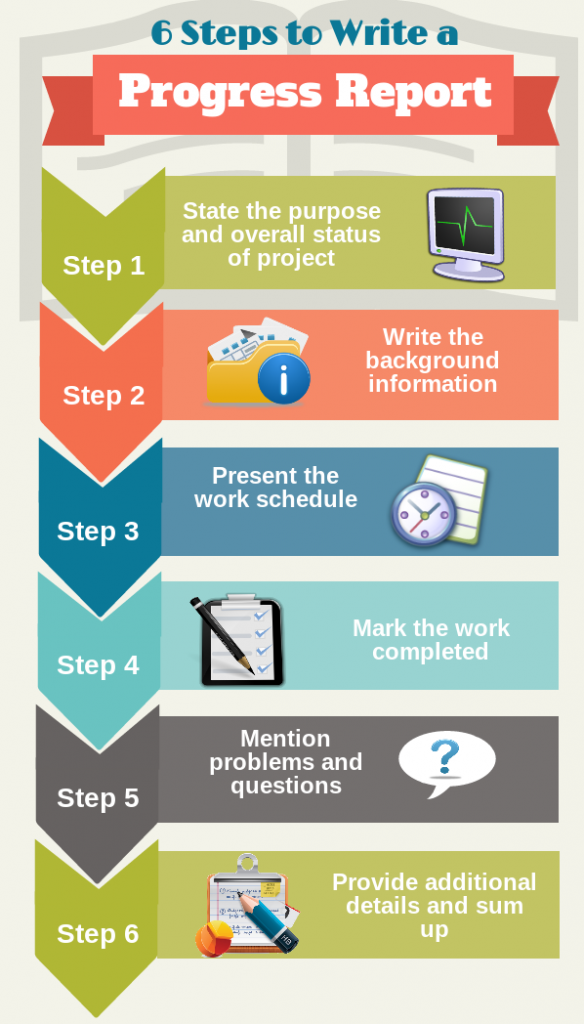10.4 Progress Reports
Progress reports are useful documents for informing project leads, managers, and clients on the status of your work on a project over a specific period of time. “It is generated at timed intervals (for example, once a month) or on completion of key stages. It records accomplishments to date and identifies any challenges or concerns. It is usually written by the project lead and is one to two pages long” (Cruthers, 2020). Whoever is paying for the project wants to know whether tasks are being completed on schedule and on budget. With the information contained in progress reports, the readers can make important decisions regarding staffing, financing, equipment or tools, along with time allocation depending on whether a project is on schedule or not. Progress reports answer the following questions for the reader:
- How much of the work is complete?
- What part of the work is currently in progress?
- What work remains to be done?
- When and how will the remaining work be completed?
- What changes, problems or unexpected issues, if any, have arisen?
- How is the project going in general?
(Progress Report: How to Write, Structure and Make it Visually Attractive, 2021)
Knowledge Check
The Purpose of a Progress Report
The main function of a progress report is informative; however, such reports may also be persuasive when reassuring clients and supervisors that you are making progress, that the project is going smoothly, and that it will be completed by the expected date — or when giving reasons why any of those might not be the case. They also do the following:
- Provide a brief look at preliminary findings or in-progress work on the project
- Give your clients or supervisors a chance to evaluate your work on the project and to suggest or request changes
- Give you a chance to discuss problems relating to the project and thus to forewarn the clients or managers
- Require you to establish a work schedule, so that you will complete the project on time
Format of a Progress Report

Depending on the size of the progress report, the length and importance of the project, and the recipient, a progress report can take forms ranging from a short informal conversation to a detailed, multi-paged report, to an infographic. Most commonly, progress reports are delivered in the following forms:
- Memo report: a short, semi-formal report to someone within your organization (can range in length from 1-4 pages)
- Letter report: a short, semi-formal report sent to someone outside your organization
- Formal report: a long, formal report sent to someone within or outside of your organization
- Presentation: an oral presentation given directly to the target audience
- Infographic: a visual narrative of your progress created with charts and graphs

Organizational Patterns for Progress Reports
The recipient of a progress report wants to see what you’ve accomplished on the project, what you are working on now, what you plan to work on next, and how the project is going in general. The information is usually arranged with a focus either on time or on task, or a combination of the two:
- Focus on time: shows time period (previous, current, and future) and tasks completed or scheduled to be completed in each period
- Focus on specific tasks: shows the order of tasks (defined milestones) and progress made
- Focus on larger goals: focuses on the overall effect of what has been accomplished
Information can also be arranged by report topic. You should refer to established milestones or deliverables outlined in your original proposal, contract, or job specifications. Whichever organizational strategy you choose, your report will likely contain the elements described below.
1. Introduction
Review the details of your project’s purpose, scope, and activities. The introduction may also contain the following:
- date the project began; date the project is scheduled to be completed
- people or organization working on the project
- people or organization for whom the project is being done
- overview of the contents of the progress report
2. Project status
This section (which could have sub-sections) should give the reader a clear description of the current status of your project. It should review the work completed, work in progress, and work remaining to be done on the project, organized into sub-sections by time, task, or topic. These sections might include the following:
- description of work completed to date, referencing work reported in previous progress reports
- timeline for when remaining work will be completed
- problems encountered or issues that have arisen that might affect completion, direction, requirements, or scope
3. Conclusion
The final section provides an overall assessment of the current state of the project and its expected completion, usually reassuring the reader that work will progress (even if you have encountered some challenges). It can also alert recipients to unexpected changes in direction or scope, or problems in the project that may require intervention.
4. References section if required.
Progress reports can be create for any type of project. Please see Figure 10.4.3 below for an example of a short progress report (formatted as a memo report) relating to the adaption of this textbook.
Sample Progress Report: Memo Format
To: Tom Bartsiokas, Coordinator
From: Robin Potter, Professor
Date: March 29, 20XX
Subject: Status of the Adaption of the EAC594 OER Text
Progress on the adaption of the EAC594 OER textbook is going well and is expected to be completed as planned by September 20XX.
Using the TEC400 OER textbook as the foundation for the EAC594 OER text, I have been tasked with adapting the text so that it is suitable for our degree-level business communication subjects at Seneca. Adaption involved revising the text so it addresses the needs of business communication students. Such revisions include
- changing content to make the text context-specific for business students
- adding chapters on types of correspondence
- adding examples and sample documents specific to business communication
- removing content most related to technical communication contexts
- adapting chapter-specific PowerPoint slide decks so they align to the new EAC594 OER text
Work Completed
As of March 20XX, I have adapted content up to Chapter 8 and removed chapters that pertained to technical communication in particular. Four chapters pertaining to the unit on correspondence have been created for this EAC594 OER:
- Chapter 7.2 Message Structure
- Chapter 7.3 Positive and Neutral Messages
- Chapter 7.4 Persuasive Messages
- Chapter 7.5 Negative Messages
Problems Encountered
At present no problems that prevent the continuation of the work on the project have arisen. Generally, the Pressbooks software is easy to use, so the project remains on track.
Work to be Completed
Sections 9 and 10 along with the appendices will be adapted before the end of the Winter term, as planned. If time permits, I will add a chapter on intercultural communication; otherwise, it will be added when I resume work on the project in the Spring term. After the completion of the chapters, the text will be ready for your review and for our technical expert, Tricia Hylton, to begin adding the 5HP interactive and visual content.
I expect to complete the adaption of the PowerPoint slide decks that will accompany the EAC594 OER text by the end of June 20XX.
Conclusion
By September 20XX, we will have a text ready for a fall pilot by our business communication faculty. I look forward to their feedback as well as the feedback of our students.
Please let me know if you require additional information.
Figure 10.4.3 Example of a progress report
To view other examples of progress reports, visit David McMurrey’s Online Technical Writing.
Knowledge Check
Using LLMs to Assist with Progress Reporting
When working with LLMs that connect to the enterprise knowledge graph (the store of organizational documents including email, files, recordings, etc.), LLMs can be very helpful at efficiently summarizing the work you have been doing on a project. The LLM can access any communications, files, and meeting recordings on the topic of your project and provide you with a rapid overview of the work done, work to be completed, and problems encountered. However, not all enterprise LLMs are given access to the knowledge graph. Such access raises issues relating to privacy, confidentiality, and over-automation.
Rather, you can make use of the LLM as an assistant to guide you through the process of creating your progress report. Remember that you are the one who has the knowledge and experience of working on the project, so the LLM is reliant on you to include relevant and useful information in the prompt. Avoid including proprietary, confidential, and private information.
Asking the LLM to Assist You in Developing a Progress Report
I am preparing a progress report for the [state the project] that is scheduled to be completed by [date]. The project has [one, two, three phases. . .choose the correct number] and we are now in [phase one, two three. . . choose one]. My purpose is to [inform, update] the reader that [state your purpose]. My audience is [describe your primary and secondary audience, if applicable]. To date, we have completed [state what you have completed] with [state what work is remaining]. During the work, I have encountered [state the problems or challenges encountered].
At this point, I need to draft a clear and informed though concise report on the progress of the project with insights so the audience understands that I am managing the project well.
Begin by asking me what other non-confidential information you need from me to help me create a complete progress report.
The LLM would then proceed to assist. Throughout the process, continue to collaborate with the LLM using questions and answers until you have developed the necessary details for the report sections. At some point, you will realize that the LLM’s capabilities are limited because it does not have all the contextual and nuanced information that only you will have. That would be the time to disengage from the LLM to proceed with revisions and supplementation on your own.
Once you have developed a report to your satisfaction, ask the LLM to review it and suggest improvements.
Progress reports are important communication documents that help to inform managers and clients on the work being done on a project. They help your audience make decisions about budgeting, human resources, materials and supplies allocation, and more. Being candid about successes and delays can result in a useful document that leads to sound decision making.
Some contents of this chapter have been adapted from McMurrey, David. (1997-2017). Online Technical Writing: Progress Reports. Creative Commons Attribution 4.0 International License
References
Cruthers, A. (2020). Business writing for everyone. https://kpu.pressbooks.pub/businesswriting/chapter/types-of-reports/
EssayShark. (2017). Six steps on how to write a progress report. https://essayshark.com/blog/infographic-6-steps-on-how-to-write-a-progress-report/
Ewald, T. (2017). Writing in the technical fields: A practical guide (2nd ed.). Oxford University Press.
McMurrey, D. (1997-2017). Online technical writing: Examples, cases, and models. https://mcmassociates.io/textbook/models.html Creative Commons Attribution 4.0 International License
Piktochart. (2021). Progress reports: How to write, structure, and make it visually attractive [Video]. Youtube. https://www.youtube.com/watch?v=yQTje_GYhb4

